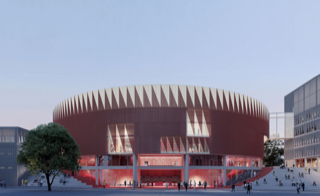(Jihlava, Czech Republic) – The result of a much-anticipated public competition, CHYBIK + KRISTOF ARCHITECTS & URBAN DESIGNERS have been selected to complete the construction of the Jihlava Multipurpose Arena – one of the largest sports and leisure complexes in the Czech Republic.
The construction, due to begin in 2021 and end in 2023, will build on the city’s existing hockey stadium, a deteriorating indoor sporting arena built in 1956, and expand into a four-building multifunctional center bringing together an adaptable ice rink, a rooftop running track and a gym as well as a sports academy, hospitality establishments and shops.
Hosting both regional sporting and cultural events, the completed structure will act as a public platform open to a variety of audiences for a diverse range of activities, in an effort to revitalize this long-neglected area of the city.
CHYBIK + KRISTOF’s design for the new Jihlava Multipurpose Arena revisits the existing structure of the building, initially developed as the home stadium for the regional ice hockey club. A multifunctional space with a capacity of 5,600 spectators, the project extends the stadium’s original purpose by creating a versatile space, adapted to both its primary sporting purposes within state-of-the-art facilities and a broad spectrum of activities – and their respective audiences.
Located on the border of Jihlava’s historical center, the arena – a structure usually confined to the periphery of cities – is adjacent to a park and university and places itself in the continuity of these two spaces. The several public spaces nested throughout the four- building “urban stadium” allow it to melt into the surrounding urban landscape. Rather than marking an interruption in the existing city structure, the arena serves as a transparent and fluid transition between seemingly distinct spaces, thereby reviving and opening up the area to new functions, and ultimately extending the city center beyond its strict historical bounds.
In this new permeable space, which the inhabitants are encouraged to invest in their daily lives, the architectural framework lays the foundations for the prominent notions of free movement and interaction.







